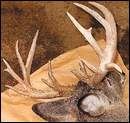
Iowan bags a 14-pointer — and it's a doe
Female deer usually don't have antlers — let alone ones this big, experts say.
By JULI PROBASCO-SOWERSREGISTER STAFF WRITER
December 17, 2005
Eric Weymiller of rural Harpers Ferry was excited about shooting a large-antlered whitetail deer during Iowa's first shotgun season.
But the excitement grew even more when he started to field-dress the animal.
"I noticed right away, it was missing some plumbing," said Weymiller, 25, who shot the animal Dec. 7 in Allamakee County.
What he thought was a buck actually was a doe — sporting antlers with 14 tines. That's a big rack, even for a buck.
"I stopped field-dressing the animal and called a DNR biologist," Weymiller said. "I wanted them to document this."
Biologist Terry Hainfield, with the Iowa Department of Natural Resources in northeast Iowa, confirmed the animal was a doe. "It is unusual to find a doe with antlers, but what makes this particularly unusual is that the antlers had hardened and grown so big," Hainfield said.
More research will be required to determine whether the antlers are of record size for a doe. Other than state officials, probably no one keeps records on doe antlers, said Jack Reneau, director of big game records for the Boone and Crockett Club, a Montana-based organization that keeps track of record antlers and horns.
"We have no antlers on record that have been from a doe," he said.
Although Reneau hears of one or two antlered does a year in the United States, their antlers have been in the velvet growing stage and have never been as large as those on the doe Weymiller shot. Velvet is like a skin that covers antlers and supplies blood so they can grow.
Weymiller will have to wait about 60 days for the antlers to dry before they can be officially scored.Hainfield said it takes a second boost of testosterone to drop the velvet and harden the antlers — and that second boost is rare for does."
There are a number of reasons a doe could have enough testosterone to grow and harden the antlers," he said.
One explanation would be that a deer had both male and female reproductive organs — but Weymiller's deer was strictly female. Another reason is a deer's body might simply produce extra testosterone. And when a deer has twins, one male and one female, in the uterus, the two fetuses can share hormones, Hainfield said, resulting in a female with additional testosterone.
1 comment:
Is this a case of "Antler Envy" gone a little too far?
Post a Comment